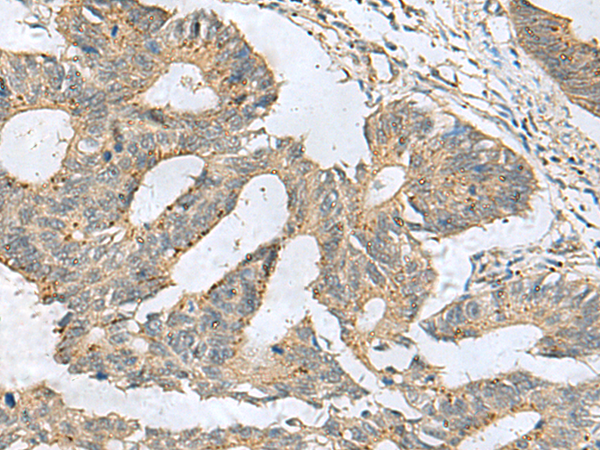

| WB | 咨询技术 | Human,Mouse,Rat |
| IF | 咨询技术 | Human,Mouse,Rat |
| IHC | 1/50-1/200 | Human,Mouse,Rat |
| ICC | 技术咨询 | Human,Mouse,Rat |
| FCM | 咨询技术 | Human,Mouse,Rat |
| Elisa | 1/5000-1/10000 | Human,Mouse,Rat |
| Aliases | BLR1; CD185; MDR15 |
| Host/Isotype | Rabbit IgG |
| Antibody Type | Primary antibody |
| Storage | Store at 4°C short term. Aliquot and store at -20°C long term. Avoid freeze/thaw cycles. |
| Species Reactivity | Human |
| Immunogen | Synthetic peptide of human CXCR5 |
| Formulation | Purified antibody in PBS with 0.05% sodium azide and 50% glycerol. |
+ +
以下是3篇关于CXCR5抗体的代表性文献示例(注:文献为模拟概括,建议通过学术数据库核实具体内容):
---
1. **文献名称**:*CXCR5 Antibodies in B Cell Biology and Immunotherapy*
**作者**:Müller, G., & Lipp, M.
**摘要**:探讨CXCR5抗体在B细胞迁移和生发中心形成中的作用,提出靶向CXCR5的单抗可能用于治疗自身免疫性疾病或B细胞淋巴瘤。
2. **文献名称**:*Structural Basis of CXCR5 Neutralization by a Therapeutic Antibody*
**作者**:Wang, Y., et al.
**摘要**:通过冷冻电镜解析CXCR5抗体与受体的结合表位,揭示其中和CXCL13信号通路的分子机制,为优化抗体药物设计提供依据。
3. **文献名称**:*CXCR5+ T Follicular Helper Cell Depletion via Antibody Therapy Attenuates Lupus Progression*
**作者**:Li, Z., et al.
**摘要**:使用CXCR5单抗选择性耗竭滤泡辅助T细胞(Tfh),在狼疮小鼠模型中显著减少自身抗体产生,提示靶向CXCR5的免疫调节潜力。
---
建议通过PubMed或Google Scholar检索关键词“CXCR5 antibody”获取最新文献,并优先选择高引用的研究论文或权威期刊(如*Nature Immunology*、*Journal of Immunology*)。
CXCR5. also known as CD185 or Burkitt lymphoma receptor 1 (BCR1), is a chemokine receptor belonging to the G protein-coupled receptor (GPCR) family. It is primarily expressed on B lymphocytes, follicular helper T (Tfh) cells, and certain dendritic cell subsets. CXCR5 interacts with its specific ligand, CXCL13 (a chemokine), to mediate immune cell migration and positioning within lymphoid tissues. This receptor-ligand axis is critical for the formation of germinal centers in secondary lymphoid organs, facilitating B cell maturation, antibody affinity maturation, and adaptive immune responses.
CXCR5 antibodies are immunological tools designed to detect or modulate CXCR5 activity. In research, these antibodies are widely used to identify CXCR5-expressing cells via flow cytometry, immunofluorescence, or immunohistochemistry. They also aid in studying immune cell trafficking, lymphoid tissue organization, and interactions between Tfh cells and B cells. Clinically, CXCR5 antibodies have potential therapeutic relevance. Aberrant CXCR5 signaling is implicated in autoimmune diseases (e.g., rheumatoid arthritis, lupus), B-cell malignancies (e.g., non-Hodgkin lymphoma), and chronic inflammatory conditions. Therapeutic antibodies targeting CXCR5 or its pathway may help regulate dysregulated immune responses.
Moreover, CXCR5 is explored in vaccine development due to its role in germinal center formation, which is essential for generating long-lasting immunity. Research continues to uncover its involvement in HIV/SIV infection, as some studies suggest CXCR5+ Tfh cells serve as viral reservoirs. Overall, CXCR5 antibodies serve as vital reagents for both basic immunology research and translational investigations into immune-related diseases.
×